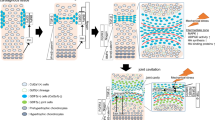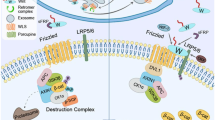Summary
Fibroblast growth factors (FGFs) are potent inhibitors of myogenic differentiation. The recent observation that the endogenous expression of acidic and basic FGF by myogenic cells decreases coordinately with differentiation suggests a regulatory role for these growth factors in myogenesis. Inasmuch as other proteins known to influence myogenesis (e.g., MyoD1 and myogenin) activate their own expression as well as the expression of other members of their family, we hypothesized that the FGFs might be capable of similar autoregulation. We examined the effect of exogenously supplied FGF on the abundance of the mRNAs encoding acidic and basic FGF in Sol 8 myoblasts, and demonstrate that either acidic or basic FGF stimulate, through paracrine mechanisms, the accumulation of the mRNAs encoding both of these FGFs. Thus FGFs can auto- and transregulate their own expression in a manner analogous to that observed for the myogenic determination proteins. In addition, similar to that previously observed for MyoD1, both acidic and basic FGF suppress myogenin expression in myoblasts. These results suggest two mechanisms whereby endogenously produced FGFs participate in the maintenance of the undifferentiated state of myogenic cells. These data provide support for paracrine, and suggest potential autocrine, roles for FGFs in the regulation of myogenic differentiation.
Similar content being viewed by others
References
Alterio, J.; Courtois, Y.; Robelin, J., et al. Acidic and basic fibroblast growth factor mRNAs are expressed by skeletal muscle satellite cells. Biochem. Biophys. Res. Comm. 166:1205–1212; 1990.
Baird, A.; Bohlen, P. Fibroblast growth factors. In: Sporn, M. B.; Roberts, A. B., eds. Receptors I. Berlin: Springer Verlag; 1990:369–418.
Burgess, W. H.; Maciag, T. The heparin-binding (fibroblast) growth factor family of proteins. Ann. Rev. Biochem. 58:575–606; 1989.
Chirgwin, J. M.; Przybla, A. E.; MacDonald, R. J., et al. Isolation of biologically active ribonucleic acid from sources enriched in ribonuclease. Biochemistry 18:5294–5299; 1979.
Cook, P. W.; Coffey, R. J., Jr.; Magun, B. E., et al. Expression and regulation of mRNA coding for acidic and basic fibroblast growth factor and transforming growth factor α in cells derived from human skin. Mol. Endocrinol. 4:1377–1385; 1990.
Gay, C. G.; Winkles, J. A. Interleukin 1 regulates heparin-binding growth factor 2 gene expression in vascular smooth muscle cells. Proc. Natl. Acad. Sci. USA 88:296–300; 1991.
Groux-Muscatelli, B.; Bassaglia, Y.; Barritault, D., et al. Proliferating satellite cells express acidic fibroblast growth factor during in vitro myogenesis. Dev. Biol. 142:380–385; 1990.
Iberg, N.; Rogelj, S.; Fanning, P., et al. Purification of 18- and 22-kDa forms of basic fibroblast growth factor from rat cells transformed by the ras oncogene. J. Biol. Chem. 264:19951–19955; 1989.
Montarras, D.; Pinset, C.; Chelly, J., et al. Expression of MyoD1 coincides with terminal differentiation in determined but inducible muscle cells. EMBO J. 8:2203–2207; 1989.
Moore, J. W.; Dionne, C.; Jaye, M., et al. The mRNAs encoding acidic FGF, basic FGF and FGF receptor are coordinately downregulated during myogenic differentiation. Development 111:741–748; 1991.
Robertson, M. More to muscle than MyoD. Nature 344:378–379; 1990.
Stirling, D.; Magness, R. R.; Stone, R., et al. Angiotensin II inhibits luteinizing hormone-stimulated cholesterol side chain cleavage expression and stimulates basic fibroblast growth factor expression in bovine luteal cells in primary culture. J. Biol. Chem. 265:5–8; 1990.
Terrell, G. E.; Swain, J. L. Indirect angiogenic agents do not release fibroblast growth factors from extracellular matrix. Matrix 11:108–114; 1991.
Thayer, M. J.; Tapscott, S. J.; Davis, R. L., et al. Positive autoregulation of the myogenic determination gene MyoD1. Cell 58:241–248; 1989.
Vaidya, T. B.; Rhodes, S. J.; Taparowsky, E. J., et al. Fibroblast growth factor and transforming growth factor beta repress transcription of the myogenic regulatory gene MyoD1. Mol. Cell. Biol. 9:3576–3579; 1989.
Yutzey, K. E.; Rhodes, S. J.; Konieczny, S. F. Differential trans activation associated with the muscle regulatory factors MyoD1, myogenin, and MRF4. Mol. Cell. Biol. 10:3934–3944; 1990.
Author information
Authors and Affiliations
Rights and permissions
About this article
Cite this article
Fox, J.C., Swain, J.L. Auto and transactivation of FGF expression: Potential mechanism for regulation of myogenic differentiation. In Vitro Cell Dev Biol - Animal 29, 228–230 (1993). https://doi.org/10.1007/BF02634188
Received:
Accepted:
Issue Date:
DOI: https://doi.org/10.1007/BF02634188




